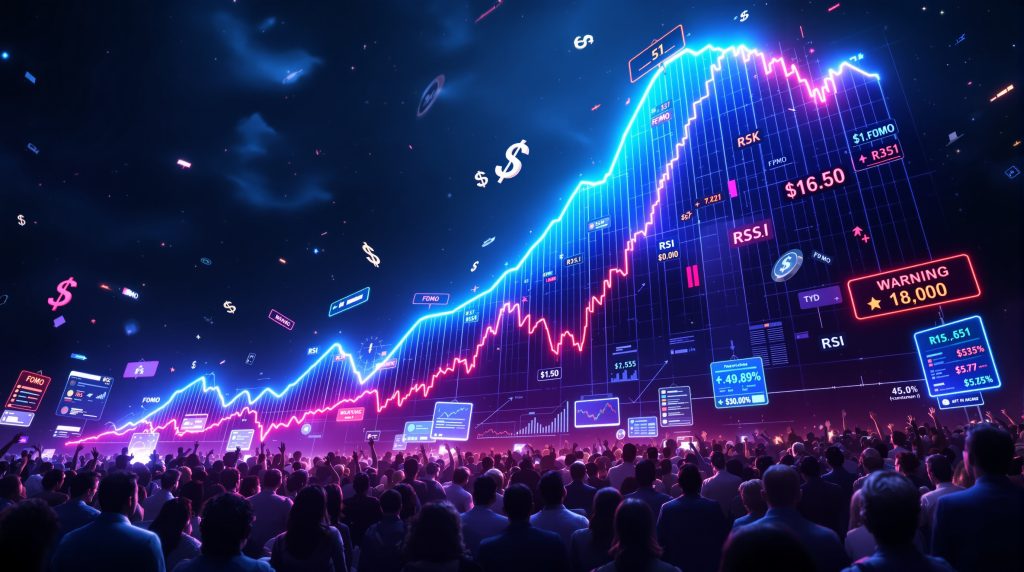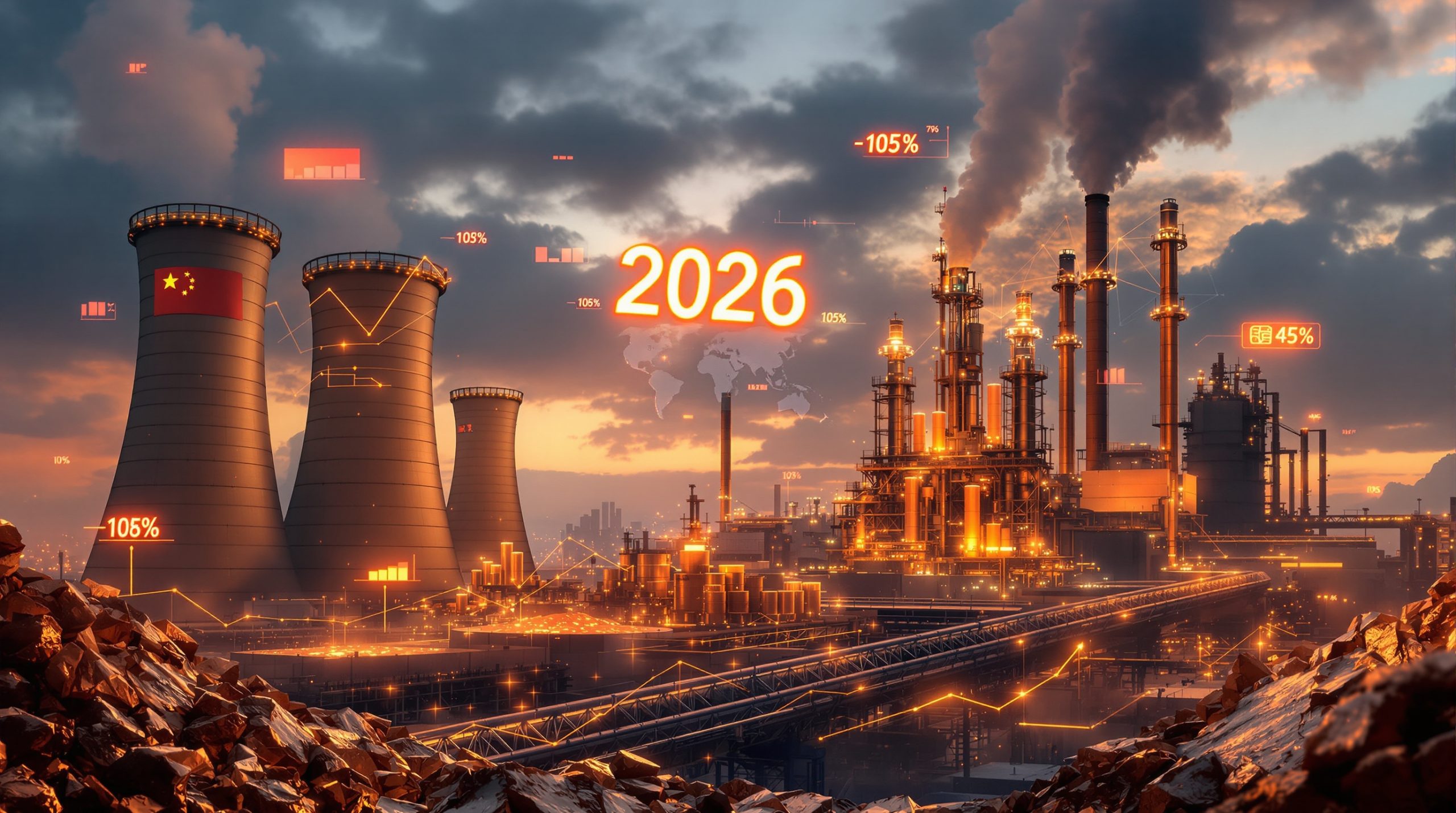Understanding the Parabolic Stock Market Phase: Signs, Risks, and Opportunities
A parabolic stock market phase represents an accelerated period of price appreciation where market values rise at an increasingly steep rate, creating a curve that resembles a mathematical parabola on price charts. Unlike normal bull markets that might see steady 10-20% annual gains, parabolic phases can deliver those returns in weeks or even days.
This phenomenon typically occurs in the final stages of extended bull markets, where price increases become exponentially steeper and more dramatic. The trajectory becomes nearly vertical on charts as investor psychology shifts from rational valuation to emotion-driven buying.
According to David Hunter, Chief Macro Strategist at Contrarian Macro Advisors, the current market represents the culmination of a 43-year secular bull market that began in August 1982. Hunter emphasizes that parabolic phases can compress "what would normally take three to four years to earn returns" into approximately 3 months.
Key Characteristics of Parabolic Market Movements
-
Accelerating price momentum: Each successive price increase happens more rapidly than the last, creating a steepening trajectory
-
Expanding trading volumes: Market participation grows substantially as more investors pile in, particularly from institutional sources previously on the sidelines
-
Diminishing price corrections: Normal pullbacks become shallower or disappear entirely, with market resilience to negative news
-
Widespread media attention: Financial news coverage becomes increasingly euphoric, with rising price targets across major financial institutions
-
Retail investor surge: Previously uninvolved investors enter markets at increasing rates, often through index funds and ETFs
Why Do Parabolic Market Phases Occur?
Parabolic market phases result from a combination of psychological, monetary, and structural factors that create self-reinforcing momentum. These phases represent the culmination of extended trends that eventually reach unsustainable extremes.
Psychological Drivers Behind Market Parabolics
Parabolic market phases are fundamentally driven by shifts in mass psychology rather than economic fundamentals. Several key psychological factors contribute to their development:
-
Fear of missing out (FOMO): As prices rise rapidly, investors who previously avoided the market rush in, afraid of missing potential gains
-
Confirmation bias: Rising prices validate investors' beliefs, making them more confident in further appreciation
-
Herding behavior: The social validation of seeing others profit creates a self-reinforcing cycle
-
Narrative reinforcement: Stories about "new paradigms" or "this time is different" gain widespread acceptance
Hunter notes that the current parabolic phase is being fueled by institutional investors who "have fought this market from the October 2022 low all the way up" finally capitulating and embracing momentum after consistently calling it "a bear market rally" and later arguing that "valuations are so high that the upside's limited."
Economic and Monetary Catalysts
While psychology drives parabolic phases, several economic conditions often serve as catalysts:
-
Excessive liquidity: Central bank monetary easing floods markets with capital seeking returns, with the Federal Reserve balance sheet evolution from $875 billion in 2008 to nearly $9 trillion during the pandemic
-
Low interest rates: When safe investments yield little, investors take greater risks for returns, accelerating during extended periods of monetary accommodation
-
Financial innovation: New investment vehicles or technologies can accelerate market participation, with passive index funds playing a significant role
-
Institutional participation: When professional investors join momentum trades after extended skepticism, they amplify movements dramatically
Hunter attributes parabolic phases to positioning within "super cycles" – the extended periods between major economic depressions. He describes the current environment as the "ninth decade away" from the 1930s Depression, suggesting we're in the "last decade of a super cycle" where "each successive cycle ends up with bigger excesses."
How to Identify a Developing Parabolic Market
Identifying a developing parabolic market requires attention to both technical indicators and psychological shifts among market participants. While traditional metrics provide warning signs, institutional behavior often confirms the transition to parabolic movement.
Technical Indicators of Parabolic Movements
Several technical indicators can help identify when markets are entering or experiencing parabolic phases:
-
Price curve steepening: Chart patterns show increasingly vertical price movements with diminishing consolidation periods
-
Accelerating moving averages: Short-term moving averages pull away from longer-term averages at increasing rates, creating extreme separation
-
Rising RSI (Relative Strength Index): Momentum indicators remain in overbought territory for extended periods without meaningful pullbacks
-
Expanding Bollinger Bands: Price volatility increases dramatically, widening technical indicator bands beyond normal parameters
-
Volume profile changes: Trading volumes increase substantially, particularly on up days, with declining volume on down days
Fundamental Warning Signs
Beyond technical indicators, several fundamental metrics often flash warning signs during parabolic phases:
-
Extreme valuation metrics: P/E ratios, price-to-sales, and other valuation measures reach historical extremes across market indices
-
Earnings disconnect: Stock prices continue rising even when earnings growth slows or reverses, with narrative emphasis shifting to future potential
-
Margin debt expansion: Investors increasingly borrow money to purchase securities, reaching historical highs relative to market capitalization
-
New investor influx: Brokerage account openings surge and trading app downloads accelerate, bringing inexperienced participants into markets
-
Speculative asset popularity: Interest in options, leveraged ETFs, and speculative assets grows substantially, with derivative volumes expanding
Hunter's identification methodology centers on institutional behavior shifts rather than traditional technical indicators. The key signal emerges when institutions begin "having to get more aggressive and allocate more to equities" after years of skepticism, shifting from fighting the trend to embracing momentum.
What Happens During the Parabolic Melt-Up Phase?
The parabolic melt-up phase represents the most extreme period of market acceleration, where traditional relationships between fundamentals and prices break down completely. This phase typically represents the final stage before reversal.
Market Behavior Characteristics
During the most intense period of a parabolic stock market phase, several distinctive patterns emerge:
-
Compressed timeframes: Price increases that previously took months occur in days or weeks, with potential gains of 50-70% across major indices in months rather than years
-
Resistance level failures: Previous price ceilings are broken with minimal hesitation, often gapping higher on market opens
-
Sector rotation acceleration: Capital flows rapidly between market sectors seeking momentum, with participation broadening beyond initial leaders
-
Diminishing importance of news: Markets rise regardless of positive or negative developments, showing resilience to potentially negative catalysts
-
Technical analysis breakdown: Traditional technical indicators lose predictive value as price movements exceed historical parameters
Hunter describes this environment as a "relentless rally" where normal market dynamics break down. He explains that "you won't have selloffs day-to-day or that you couldn't see a 3 or 4% sell off at some point, but mostly it's going to be upside and upside steep."
Case Study: Historical Parabolic Market Phases
The 1999-2000 dot-com bubble exemplifies a classic parabolic stock market phase:
-
The NASDAQ rose approximately 85% in just the final five months of 1999, with many technology stocks doubling or tripling in weeks
-
Trading volumes in technology stocks tripled during the same period, with record-breaking participation
-
Companies with no earnings saw valuations increase by billions based solely on concepts and future potential
-
Retail investor participation reached unprecedented levels, with taxi drivers and barbers offering stock tips
-
The subsequent crash erased nearly 80% of the NASDAQ's value over the next two years, with many companies disappearing entirely
How Do Parabolic Market Phases End?
Parabolic market phases inevitably end with dramatic reversals, often surprising even those who anticipate them. The precise timing remains challenging, but certain signals can help identify potential inflection points.
The Inevitable Reversal
Parabolic market phases invariably end with dramatic reversals for several reasons:
-
Exhaustion of buyers: Eventually, no new capital remains to push prices higher, creating a vacuum when momentum stalls
-
Valuation extremes: Even the most optimistic narratives cannot justify astronomical valuations when stretched to mathematical impossibility
-
Technical fragility: Parabolic structures lack supporting consolidation levels, creating air pockets during reversals
-
Trigger events: Often a seemingly minor news event causes initial selling that cascades as leveraged positions unwind
-
Leverage unwinding: Forced selling occurs as borrowed money positions are liquidated, accelerating downside momentum
Hunter warns that tops occur when institutions adopt an "all-in type of mentality" and begin saying "this is a bull market that has legs and can carry." The reversal pattern may involve initial declines of "10 or 15 or 20%" followed by bounces "back within five or 7% of the highs and then go down."
Warning Signs of Impending Collapse
Several indicators often precede the collapse of parabolic market phases:
-
Divergences in market breadth: Fewer stocks participate in the final stages of the rally, with indexes supported by a narrowing group of leaders
-
Smart money withdrawal: Institutional investors begin reducing positions quietly while maintaining bullish public stance
-
Insider selling acceleration: Company executives increasingly sell their own shares while expressing confidence publicly
-
Initial failed rallies: For the first time, strong buying does not produce new highs, creating technical divergences
-
Volatility expansion: Price swings become more extreme in both directions, with larger intraday ranges
Hunter emphasizes the unpredictability of exact timing, noting "I don't know what that day is, but you're going to go someday" from "a spike up to a spike down." The challenge involves avoiding both premature exits and late-stage entries driven by FOMO.
What Are the Investment Implications of Parabolic Markets?
Navigating parabolic market phases requires balancing the potential for outsized short-term gains against the inevitable reversal. Strategic positioning becomes critical as markets approach extremes.
Risk Management Strategies
Investors can employ several strategies to navigate parabolic market phases:
-
Trailing stop losses: Automatically lock in gains if prices reverse by predetermined percentages, allowing participation while limiting downside
-
Position sizing reduction: Gradually decrease exposure as parabolic acceleration increases, taking partial profits systematically
-
Options hedging: Purchase protective put options to limit downside risk while maintaining upside exposure
-
Sector diversification: Avoid concentration in the most parabolic market segments, rotating toward relative value opportunities
-
Cash reserve building: Systematically move some gains to cash as markets become more extreme, creating dry powder for post-crash opportunities
Hunter warns about the psychological trap of early exits, explaining that "if you go up 30 or 40% from here, the likelihood is those that get out now are going to be forced back in." This creates a scenario where investors who exit prematurely often re-enter near the top due to FOMO.
Potential Opportunities
Despite their dangers, parabolic markets can offer opportunities for prepared investors:
-
Selective participation: Focus on higher-quality companies within trending sectors, emphasizing strong balance sheets and cash flow
-
Rotation strategies: Move capital to less extended market segments as bubbles form, identifying relative value opportunities
-
Contrarian positioning: Begin building positions in overlooked sectors that may lead the next cycle, particularly commodities
-
Post-crash preparation: Develop watchlists of quality companies to purchase after the inevitable decline, with capital ready to deploy
-
Alternative asset allocation: Consider assets with low correlation to equities markets, potentially including precious metals and real assets
Hunter projects significant opportunities following the eventual market reversal, with commodity markets potentially experiencing dramatic upside. He forecasts record gold prices reaching $20,000 and silver $500 by the early 2030s, with oil potentially reaching $500 per barrel and copper $20-30 following an initial deflationary bust.
How Does Market Psychology Drive Parabolic Phases?
Market psychology plays the dominant role in parabolic market phases, with rational valuation frameworks increasingly abandoned as momentum accelerates. Understanding these psychological patterns can help investors navigate extreme market conditions.
The Psychology of Market Extremes
Parabolic market phases represent classic examples of crowd psychology and behavioral finance principles:
-
Recency bias: Investors project recent extreme returns into the future indefinitely, extrapolating short-term trends
-
Availability heuristic: Stories of overnight wealth creation become mentally prominent, while cautionary tales are dismissed
-
Overconfidence effect: Successful investors attribute gains to skill rather than market conditions, increasing risk-taking
-
Social proof dynamics: Investment decisions increasingly rely on what others are doing rather than independent analysis
-
Narrative-driven investing: Compelling stories override fundamental analysis, with valuations justified through increasingly creative frameworks
Hunter's psychological model focuses on contrarian indicators derived from institutional positioning. He explains that "the thing that's kept me so bullish has been that the institutions have been so cautious and so skeptical." The parabolic phase accelerates when this skepticism transforms into momentum chasing.
The Role of Media and Information Cascades
Modern media and information environments accelerate parabolic phases:
-
Echo chamber effects: Social media algorithms reinforce existing beliefs about markets, creating information bubbles
-
Influencer amplification: Financial influencers with large followings can trigger capital flows through recommendations
-
24-hour market coverage: Continuous financial news creates a sense of urgency to participate, highlighting winners while minimizing risks
-
Success story prominence: Media highlights extreme winners while ignoring risks, creating skewed risk perception
-
Information cascades: Investors increasingly base decisions on the observed actions of others rather than independent research
According to Hunter, retail investors have been "pretty savvy about this and stayed right through" while professionals remained cautious. The psychological shift occurs when institutions finally "say, you know, we got to get on board," representing the classic late-cycle psychology where previously cautious professionals embrace risk.
What Can We Learn from Historical Parabolic Markets?
Historical parabolic market episodes provide valuable insights into current market dynamics. While circumstances differ, the underlying psychological and structural patterns show remarkable consistency across different eras.
Lessons from Past Parabolic Episodes
Several historical parabolic market episodes offer important lessons:
-
1929 Stock Market: The Roaring Twenties culminated in a parabolic rise before the Great Depression
- The Dow Jones Industrial Average nearly doubled in the 18 months before its peak
- Following the crash, it took 25 years to regain previous highs
-
1980s Japanese Asset Bubble: Japan's Nikkei 225 experienced a classic parabolic rise
- The index tripled between 1985 and 1989, reaching nearly 39,000
- More than 30 years later, the Nikkei still hasn't fully recovered its peak values
-
2017 Cryptocurrency Bubble: Bitcoin and other cryptocurrencies showed textbook parabolic behavior
- Bitcoin rose from $1,000 to nearly $20,000 in less than 12 months
- Subsequently fell more than 80% in the following year before beginning a new cycle
Hunter's historical framework emphasizes the cyclical nature of market extremes within super-cycles. He explains that "as you get farther removed from the depression, those cycles get more violent or get more extreme." Each successive cycle involves "bigger excesses in various places" requiring "more of ratcheting down tightening down from the Fed."
Common Patterns Across Different Eras
Despite occurring in different time periods and asset classes, parabolic market phases share common elements:
-
They typically emerge after extended periods of above-average returns, with participants becoming conditioned to buy dips
-
Technological or financial innovation often provides the narrative backdrop, creating stories about paradigm shifts
-
Claims of "new paradigms" or "this time is different" become widespread, justifying abandonment of traditional valuation frameworks
-
The final acceleration phase is remarkably brief compared to the preceding bull market, compressing years of normal returns into months
-
The subsequent decline typically erases most or all of the parabolic phase gains, often overshooting to the downside
Hunter traces the evolution from the $875 billion Fed balance sheet in 2008 to $9 trillion during the pandemic, illustrating the escalating nature of interventions. This progression demonstrates the pattern of increasing policy responses to successive crises, with each intervention creating larger imbalances requiring more dramatic corrections.
How Should Investors Prepare for Potential Parabolic Markets?
Strategic preparation for parabolic market phases requires balancing participation with prudent risk management. Investors can develop frameworks that allow them to capture upside while protecting against inevitable reversals.
Strategic Preparation for Different Scenarios
Prudent investors can prepare for potential parabolic market phases in several ways:
-
Develop predetermined exit strategies: Decide in advance at what points you'll reduce exposure, creating mechanical rules that override emotion
-
Maintain investment discipline: Stick to allocation targets by rebalancing as markets rise, systematically harvesting gains from outperformers
-
Focus on absolute rather than relative returns: Avoid the trap of comparing to extreme performers, maintaining reasonable return expectations
-
Prepare psychologically for volatility: Understand your emotional responses to extreme movements, developing mental frameworks for handling uncertainty
-
Build a contrarian mindset: Train yourself to become more cautious as euphoria increases, using sentiment indicators as contrarian guides
Hunter's preparation strategy involves understanding the timing challenges of parabolic phases. He warns against early exit due to the potential for "30 or 40%" additional gains from current levels, while emphasizing the importance of recognizing when institutional sentiment reaches extreme bullishness.
Building an All-Weather Portfolio
Creating a portfolio that can withstand parabolic phases and their aftermath requires:
-
True diversification: Include assets with fundamentally different drivers of returns, beyond traditional stock/bond allocations
-
Value-oriented core holdings: Maintain significant exposure to reasonably valued investments that generate cash flow
-
Tactical flexibility: Establish rules for adjusting allocations as market conditions change, with defined triggers for action
-
Cash reserves strategy: Determine how much capital to keep available for post-crash opportunities, potentially increasing as markets extend
-
Risk parity approaches: Balance portfolio risk contributions rather than just asset allocations, preventing concentration in high-volatility segments
Hunter projects a dramatic shift in leadership during the next market cycle. He anticipates a global recession outlook followed by "25% inflation by 2032 or three," with the post-bust environment favoring commodities due to "reshoring and focusing on re-industrialization of the US" combined with massive monetary expansion.
FAQs About Parabolic Stock Market Phases
What is the typical duration of a parabolic market phase?
The most extreme parabolic phases typically last between 3-9 months, though the buildup may occur over 1-2 years. The steepest portion of the curve often happens in the final 4-8 weeks before the peak. Hunter suggests the current parabolic phase could complete in "a matter of a few months" or potentially extend into early 2025, but emphasizes that "parabolics burn out" due to their unsustainable nature.
Can parabolic market phases be predicted?
While the exact timing cannot be predicted, conditions that foster parabolic phases can be identified, including excessive liquidity, extreme investor sentiment, and disconnects between prices and fundamentals. Hunter's methodology focuses on institutional positioning as a contrarian indicator, with the capitulation of previously skeptical professional investors serving as a key signal for parabolic acceleration.
Do parabolic markets always end in crashes?
Yes, by their mathematical nature, parabolic price structures cannot be sustained indefinitely. The correction is typically proportional to the steepness of the parabolic rise, with most historical examples showing 70-90% declines in the most extreme sectors. Hunter anticipates a "global deflationary bust" following the current parabolic phase, representing a significant economic contraction.
What sectors are most prone to parabolic behavior?
Technology, speculative commodities, and emerging industries with uncertain but potentially revolutionary futures tend to experience the most dramatic parabolic phases. These sectors benefit from narrative-driven investing where valuation metrics are difficult to apply. Hunter notes that while technology has led the current advance, "there's lots of other groups that are starting to participate as well," suggesting broadening market participation.
How should retirement investors handle parabolic markets?
Retirement investors should focus on systematic rebalancing during parabolic phases, gradually reducing exposure to the most extended market segments while maintaining long-term investment plans. Attempting to time exact market tops is not recommended for long-term investors. Hunter warns that the psychological trap involves getting "forced back in" after early exits, suggesting disciplined partial profit-taking rather than all-or-nothing approaches.
Disclaimer: The views expressed in this article, particularly regarding specific price targets and market forecasts, represent the opinions of market strategists and are not guarantees of future performance. All investing involves risk, and particularly so during parabolic market phases. Investors should conduct their own research and consider their financial circumstances and risk tolerance before making investment decisions. For those looking to build a solid foundation, focusing on investing basics and understanding gold prices analysis can provide valuable context for navigating current market conditions. Additionally, keeping abreast of the US economy outlook is essential for informed decision-making.
Want to Spot the Next Major Mining Discovery Before the Crowd?
Discovery Alert's proprietary Discovery IQ model instantly notifies investors when significant mineral discoveries are announced on the ASX, providing a decisive market advantage for both short and long-term investors. Explore historic returns of major mineral discoveries and how they've transformed companies at https://discoveryalert.com.au/discoveries/.




